Welcome to the week 1 lesson in the June Herb Challenge here on GrowingUpHerbal.com.
Like I said before in the Herb Challenge Intro, I hope that this challenge not only teaches you a bit about the herb calendula and has you getting your hands dirty using it in a few different ways, but I hope to engage with you on a more personal level as well. I hope that this herb challenge pushes you forward a bit and helps get you motivated to delve into the world of herbs in order to keep your family healthy and heal them when they aren’t.
Over the course of this challenge, we’ll be learning a good bit of information on the herb calendula as well as talking about some of its most common uses. This information will build on top of itself each week so that by the end of the month, you should have a nice bit of info learned when it comes to this herb. If you have any questions during the course of this challenge, ask away in the comment section below.
Okay, so let’s dive right in!
Calendula
Calendula is one of those herbs that is most commonly used locally… meaning its therapeutic action takes place in one specific area, not in the whole body (systemic). It’s for this reason that calendula is a great herb for skin conditions. I’ll explain this further in just a second.
Calendula has antiseptic, antibacterial, antiviral, antifungal, anti-inflammatory, and astringent actions in the body… all making it ideal for the skin. It’s also thought to help heal wounds faster as it increases the oxygen flow to the wound causing the cells to regenerate more quickly.
Some common uses of calendula are to treat infected areas on the body like sores and cuts as well as fungal outbreaks like athletes foot or yeast infections. It can also be used on swollen, painful, or inflamed areas of the skin such as eczema, bug bites, and burns. The fact that calendula has an astringent action makes it particularly helpful for many of the above mentioned uses. An astringent causes the surrounding tissues to tighten up or contract which is helpful in drawing things out of those tissues… such as infection, poisons, or foreign objects like splinters.
Safety of Calendula
Calendula is one of those herbs that can be used on anyone regardless of age. It has no known side effects or toxic levels. However, everyone is different and some people who have allergies to ragweed may also be allergic to calendula.
To test for an allergic reaction, make a strong cup of calendula infusion and drink 1 tsp. Wait 30 minutes. If no reaction occurs, drink 1 TBSP. Wait another 30 minutes. If no reaction occurs then, drink 1/2 cup. Wait again, then try 1 full cup. If you have no reaction after all of this, it’s very unlikely that you are allergic to calendula.
Now that you know a bit about how calendula is beneficial for the skin, let’s get hands on and make something using it!
Week 1 Project – Calendula Infused Oil
This week we’ll be making an herbal infused oil with calendula flowers. Infused oils are great because they extract fat soluble vitamins, volatile oils, and resins from plants. Calendula just so happens to contain these constituents so making an infused oil from it is a great way to make these benefits available to you. Calendula oil is a very soothing, moisturizing oil that contains all of the therapeutic properties that were mentioned above.
Now there are many ways to make infused oils. Some are better than others, but I’m not going to discuss all those ways here today. If you’re interested in some in-depth learning on herbal infused oils, check out my Ultimate How-To Guide To Infusing Herbal Oils. It will explain everything. Today, I’ll be showing you how to infuse an herbal oil as I discuss it on my “Using Herbs – Infusing Oils” page.
Before we get started on our project, let me tell you some different ways you can use this oil once it’s made.
- after-bath oil
- massage oil
- eczema oil
- base oil for salve, cream, or lotion
- base oil in soaps
- oil in facial serum
- minor wound oil
- ear drops for ear infections
I’ve also included a bonus recipe below that uses this infused oil. Feel free to use the infused oil you just made or to make more for this recipe. Just be sure you don’t use all of your calendula flowers as we’ll need more of them for our other projects during the month!
Making Calendula Infused Oil
1. Using a glass measuring cup, add calendula flowers to the 2 oz mark. Put flowers in a saucepan. Next, fill your glass measuring cup with sweet almond oil to the 4 oz. mark. Add this to your herbs in a saucepan.
2. Heat over LOW heat for 30 minutes to 1 hour.
3. Strain herbs using a stainless strainer, a cotton muslin bag, or an old piece of fabric. Compost herbs.

4. Bottle herbal oil and label.
Bonus Calendula Recipe
The recipe you will find below can be used with the infused oil from today’s project. Enjoy, experiment, and have fun!
Calendula Healing Salve
- 4 oz. calendula infused oil
- 1/2 oz. beeswax
- 10 drops each tea tree and lavender essential oil
Infuse herbs into oil. Strain and compost herbs. Reserve 4 oz of herbal oil. Combine oil with melted beeswax over low heat. Pour into a 4 oz. tin or glass jar. Add essential oils and let sit until salve is hardened. Label and store.
Week 1 Mini-Quiz
Okay, so below are questions to answer to see what you remember from the above info. Try to answer them without looking back, but if you need to, it’s really no big deal. Most things in life are open book so don’t beat yourself up over needing to look back.
- Does calendula have action locally or systemically?
- Name one plant constituent that is extracted by infusing herbs into oil.
- What is one of the therapeutic actions of calendula?
- What does an astringent do to the body’s tissues?
- Name two ways to use calendula oil on the skin.
All finished! Way to go!
Next Week…
Okay, so that’s it for this weeks herb challenge. I hope you’ve learned a little something about calendula as well as how to quickly infuse herbs into oil. Come back next week for some more specific information on this plant and an all new herb project!
If you’re just coming across this herb challenge and you’d like to participate, CLICK HERE to learn more about the challenge itself, to access the materials list for the challenge projects, and to access each week of the herb challenge.
Now it’s your turn! In the comment section below, tell me one thing you learned about calendula this week. You can also share one way you’re planning on using it in your family, and of course, if you have any questions about this weeks lesson, leave them below. I’ll respond to them as soon as I can!
References:
http://www.herbmentor.com http://www.herbworld.com/learningherbs/calendula.pdf https://www.botanical.com/botanical/mgmh/m/marigo16.html The Green Pharmacy Herbal Handbook by James A. Duke, Ph.D. The How To Herb Book by Velma Keith and Monteen Gordon Practical Herbalism by Philip Fritchey, MH, ND, CNHP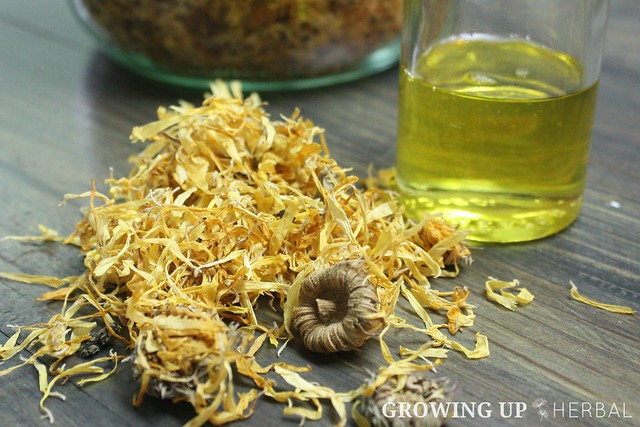
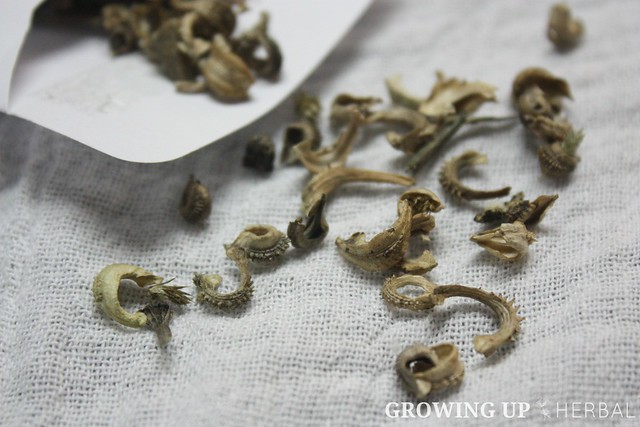
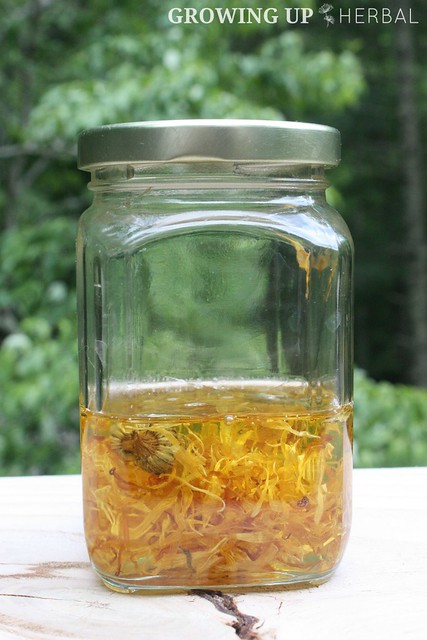

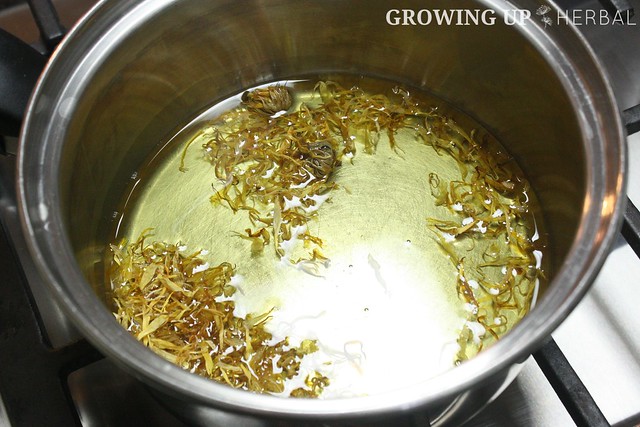
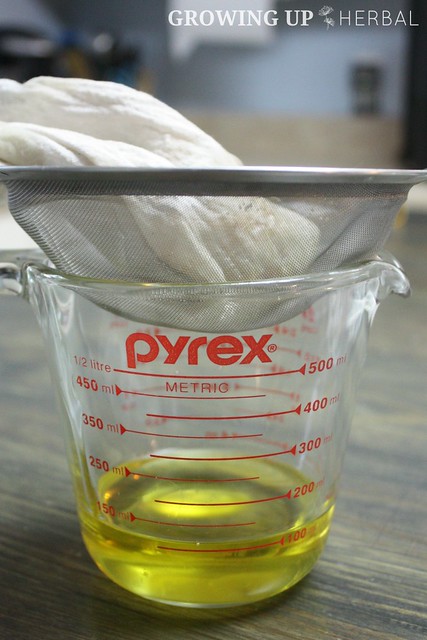
It didn’t occur to me that oil would extract the oil soluble vitamins (DUH me). Do you know what vitamins are in calendula? My other question, due to a mild nut allergy, I don’t use almond oil, can I use olive oil, or would you recommend another oil? And with olive oil, would you use the same method, or, a cold infusing method? Thanks so much.
There isn’t a whole lot of research (at least that I could find) on the nutrients found in calendula. Most of the info out there is on their medicianal value. As far as nutrients go, their flavonoids and carotenoids are what they’re known for, and when looking at specific vitamins in the flower, vitamin A is all I could find.
Also, you can use any carrier oil you like. I like lighter oils like sweet almond oil because they absorb into the skin well, but you can use olive oil or another oil that won’t bother your nut allergy. Fractionated coconut oil works well too. As far as the infusion method, you can use either one you prefer.
This is fun! I am going to use the oil to make a face serum 😀 Thanks for these challenges! They’re educational and fun, but purposeful too!
That’s a great idea! Calendula would make a great addition to a face serum!
I will also be using the oil for my face (oil cleansing) and I think I am going to make a double batch to also have some on hand for skin irritations that are bound to occur this summer. Thank you for doing this!
You’re welcome, and I agree about keeping some on hand. After I made this, my 4 year old got a bad burn from hot chocolate, and I was so glad I had this to put on the burn. It’s already healing and looking better.
I had never heard of this herb before so all information is new. I am going to make the oil so that I can use it on my daughter’s eczema. I have been looking for ways to treat it naturally and hope this oil will help. Thank you for the information.
You’re welcome Nichole. Let me just say… if it doesn’t help her eczema, don’t give up on the herb itself. Eczema, as you know, is a battle. It’s best to combine multiple therapies to heal it… all depending upon the root cause of it. So glad you’re participating!
Thank you so much for sharing your knowledge with us. Your site is a blessing!
You’re welcome, and thank you!
Have been using calendula as one component of a salve. I learned just how heat infusing herbs extracts the best that the herb has to offer. I prefer to let my oils be heated by the sun but sometimes we need something faster. We use both the stove and the crockpot.
Love it Kori! Same here! Thanks for sharing your knowledge with us.
I love using the almond oil with the calendula 🙂 there are so many skin healing properties in this herb. Do you know if this infused oil would be good to get rid of or help alleviate poison oak or ivy? Thanks!
Great question Jalice. I’m sure calendula would work well for poison oak or ivy, but I don’t think I’d personally use the oil on it. I think I’d want the herb to come into direct contact with the rash so a type of poultice may be best. For example, taking calendula flowers and just barely moistening them with boiling water, then putting them in the blender with some aloe vera gel and blending that together. It would make a great topical application for the rash. You could also make a strong calendula infusion and use that to wash the rash a few times a day. Calendula is an astringent, and astringents tend to work well on weepy rashes like poison oak and ivy. Stay tuned for upcoming challenges as we’ll be discussing infusions and poultices later on!
Thank you Meagan,I learned so much more on what my favorite herb can do. I always use Calendula as one of my herb for my salve. I will use the herb oil for my eczema that is on my eyebrows and inside my ears. Lately, I’ve been using garlic oil for my ears because of infections, but who wants to smell like garlic oil? Right? Sometimes the pain and itch are very sharp. I am on the liver cleanse and eating lots of dandelions in my salads.Eczema is slowly going away, its not as bad as I use to get it. I also use the crockpot, but this time I did the infused oil for an hour on low like you said in your recipe.I like your method for emergency, so much faster! Tonight I will add couple drops of sweet almond Calendula oil to my ears.
Thanks for your comment Monica. You know, I too prefer the crockpot method as I feel it extracts the properties really well, but honestly, the best method you can use to infuse your oil will depend on the herb you’re infusing. Calendula is a soft herb (because it’s a flower) and it yields its constituents fairly well so it doesn’t take a whole lot of heat or time to get a good infusion… which is why the stove top method works well. If I were infusing a hard herb like a root, I’d definitely do a 2 week lunar cold infusion or a crockpot heat infusion.
Two week lunar cold infusion?? You mean after a full moon? Does that really work??
Yes, but you don’t necessarily have to wait on a full moon. I like to do my lunar infusions anytime the moon is increasing… as in going from a new moon to a full moon. The reason is because, from my understanding, the earth’s gravitational pull is stronger during that time and supposedly that helps to pull more of the properties from the herb. Older herbalist stand by it so I go with it too. I don’t always do lunar infusions since they take a while, but if I’m not in a hurry, I definitely don’t mind waiting.
I love this challenge and I want to participate as much as possible, but due to personal challenges, I may have to do the projects themselves later, so I’m making a pinterest board called herbal challenge, so I can come back and do the projects when financially able, and others can get exposure to this. so since this is going to be a monthly challenge, what should I also consider purchasing ahead of time, I’m on a fixed income getting money monthly so if you in future posts, could you list ingredients that we might using in the next challenge about a week ahead of time like before the first of the month, I’m sure I’m not the only person who could use the advance notice to, Thank you ahead of time for considering this idea. grandma lori
That is totally fine Lori. You don’t have to do the projects to get any of this info… it’s all free. Participating in the projects just put you in the drawing for the prize at the end of the challenge. You can definitely do the projects later. As far as future challenges, my goal is to see how this challenge goes and then decide on more challenges in the future. As far as this year goes, challenges won’t be on a monthly basis, but more like every other month. I’ll try to plan out the next two if I decide to continue with them and I’ll let everyone know in a blog post and via an email what the supplies for both will be. Great suggestion… thank you!
Thanks, I love the challenge, even though I am mostly home bound I have always loved learning, and I will be a life long learner thanks to the Internet, hope you will continue, it’s easier this way, and more fun. Thanks again.
You’re welcome!
ALSO I HAD ONE MORE QUESTION I THOUGHT TO MAKE AN INFUSED OIL EVEN HEATED THAT THE HERB HAD TO SOAKED IN THE OIL LONGER, IF NOT THIS MEANS I CAN DO THIS WITH OTHER HERBS THAT i HAVE NOW, LIKE EUCALYPTUS, JUNIPER BERRY, AND FENNEL. OR IS IT DIFFERENT FOR DIFFERENT HERBS DEPENDING ON THE PART YOUR USING.
Yes, it’s different for different herbs… depending upon whether they’re hard or soft herbs. Calendula is soft so a 30-60 minute stovetop infusion is fine. However, a root or bark would need to infuse longer.
How long would you recommend for flowers, like rose or lavender,also what about fennel, juniper berries, and also dried citrus peels. And what about rose water. I’m sorry for all the questions, but I’m just starting to try to make some of my own.
I’d say 30-60 minutes for flowers and upwards of 2-3 hours for fennel, berries, and citrus peel. I’m not quiet sure what you mean by rose water. That’s not used in oil infusions. Do you mean, “how to make rose water?” If so, I’ll address that in another herb challenge as it’s a bit lengthy.
I did not know that calendula was topical rather than systemic.
Well what I said was that calendula is mainly used locally not systemically. It’s not limited to topical use only… it can be taken internally. We’ll talk more about it in the coming weeks.
I use theCalendula oil in my ears and the oil opened my ears enough to get my hearing aid mold into the ear to hear. But oh it was loaded with dead skins this morning, but the itch and pain left me. YAY! I use the oil for my eyebrows and face,the oil improve the dryness of the eczema but my face broke out in tiny little white head. I feel like a teenager again breaking out.
I love the way you mention to test the herb to see if we were allergenic . I had no reaction drinking the Calendula tea,never cross my mind to test the herb. Should we test all the herbs we use?
I made the Calendula herbal salve, out of the crockpot, using olive oil, that I prepared ahead of time. It turned out harder than I expected, because I use little bit more bees wax from my area. I had a farmer who kept bees to give me bees wax. It’s okay because of summer time the heat would melt my salve while taking it to family outings. Probably take a cooler to keep my herbal medicine,salves,etc.. Thank you for all your hard work putting this together, I’m having a better understanding how to use herbs.
You don’t have to test all herbs, but it’s a good idea to test those that are related to possible allergens… like calendula since it’s related to ragweed. As far as your salve being too hard… you can always re-melt it and add a bit more olive oil to soften it up. Just a suggestion.
Thank you Meagan I will add more olive oil. Just too hard…
Meagan- I am so happy that you did this challenge! I’ve actually never heard of calendula before. I am very new to learning about herbs so all of your wonderful information list above is new to me:) I haven’t received all of my supplies yet so I haven’t made my oil yet. I plan on making the healing salve you listed as well. My daughter has terribly dry skin and I haven’t found anything so far that heals that does not burn/hurt her. Thank you so very much for helping us all learn a more natural way to care for our families 🙂
You’re so welcome!
What do you use for your labels? =)
Anything I have on hand… paper, stickers, pretty washi tape… whatever. The label in the photograph is a chalkboard label I bought in the dollar section at Target. I prefer to use things that are waterproof or at least won’t be ruined if water gets on them. Hope that helps! Thanks for your comment Morgan!
Ordered my flowers tonight so I’ll be catching up next week when my shipment arrives! First question…Is there anything to consider with growing and drying the flowers at home? I found a packet of seeds the other day and thought I’d throw them in a large pot as an experiment. They are a mixed variety – looks like maybe orange and yellow?
Second question…you mentioned fractionated coconut oil as an alternative to the almond oil. Why is fractionated preferred over virgin coconut oil/what is the difference?
The only reason I suggested it is because it doesn’t harden up as it cools… it stays liquid which is what most people want with an infused oil. You can definitely infuse herbs into regular ole’ coconut oil… you just may have to heat it up to melt it if it hardens up though.
Yes… we’ll talk about growing calendula later on, but for now, you’ll want to make sure you buy the medicinal version of calendula, not the more common ornamental versions. You want to be sure the calendula seed is Calendula officinalis seeds… not any of the French or dwarf varieties.
I have not received my supplies yet but am anxious to make the oil. Last summer I infused witch hazel with calendula and made another batch with rose petals. I use the infused witch hazel for a facial toner and for bug bites. The mosquitoes are pretty bad in the Fort Hood area where I am helping my son while his wife is deployed.
I made rose and calendula vinegars also. Thank you for putting together the challenge. I was really missing access to my daughter’s garden and the herbal projects I did last year. Your challenge encouraged me to adapt to my current circumstances.
Thanks for joining us Dianne! I love the idea of infusing calendula in witch hazel. That makes a great facial toner! And good for you for adapting to the different circumstances you’re facing. For me, it’s the other way around… I usually have to adapt to using fresh, wild-crafted herb instead of herbs I’ve bought online or from the store. It goes to show that not everyone comes at using herbs from the same angle. Thanks so much for your comment, and thanks so much to you and your family, for all the sacrifices you make in serving our country!! My family appreciates what your family is doing for us!
I started my infusion tonight. I’m doing a solar method because I’m not in a rush. I also want to know if you use a dedicated set of cooking tools just for herbs?
Good for you Donnisha! Solar infusions make great infused oils. I think the time and effort in making them go a long way as far as the quality of oil you end up with.
As far as whether or not I having a dedicated set of cooking tools… well it depends on what it is. When it comes to pans, no. I use the same pans I cook in since I use stainless steal and they get washed well after each use so there are no residues left behind (food or herbal). Same goes for stainless and silicon utensils or glass jars that are used for infusing oils. Now when it comes to blenders and things that are harder to clean, I do have separate tools for these. Some people like to keep everything separate and that’s fine. For me, I don’t want more to keep up with in my kitchen. If I can clean the tool really well, I’m not worried about cross-contamination, but if I can’t (like in the case of blenders) I’ll keep separate things on hand. Now I will say that it’s different if you’re making products to sell. When I have my herbal skincare business up and running full-time on Etsy, I did have separate tools for everything.
Thanks for your comment. Glad you’re joining in on the challenge!
Thank you so very much for explaining the lunar infused oils, in this exact and particular way. It’s finally set in me to understand this and the “Why” of doing it, far better than I ever have understood this in the past. Because of your knowledgeable way of telling this on your blog, I will now likely be making as many of my oils “Lunar”, as often as I can, knowing “why”, it will turn out to be, a much better quality oil for what ever it’s to be used for.
For the purpose of a better quality made infusion, would you think we should always prefer to make them in this way when using “soft” herbs…as long as there is time to do so of course?
Bless you from those of us who don’t know what you know…but are trying to learn from you the “Why” as well as the “How”, when making herbal infusions.
So glad it was helpful Linda! As far as making the best infusion possible goes… my guess would be that 2 week infusions would be ideal as the oil has a good amount of time to infuse into the plant material, but I don’t think that’s always necessary. I personally prefer infusing oils via a heat method. I just feel like warming the oils helps the process along and shortens the wait time. I’ve never had a problem with any of my infusions not turning out or being weak. I suppose really it’s just a personal preference. Thanks for your comment!
[…] what are you waiting for? Head on over to review the first challenge & get […]
Thanks for all of the useful info on herbs, Meagan! I have many patients who regularly use herbs and oils and notice amazing results. I’ve starting researching more and came across your website; great information!
Thanks so much Dr. Kipp. Glad to have you here!
I am a huge fan of calendula and despite a fun ragweed allergy I appear not to be allergic to calendula. Huge blessing with my four kids constantly battling eczema. So I am growing calendula this year and would love any tips/resources you might have on when/how to best harvest and dry these beautiful flowers/herbs. Thanks so much for all the info! I did the herbal infusion and added some plantain and lavender to a batch…it is heavenly!
We’ll be discussing growing calendula soon! Thanks Sarah, and I loved that you went above and beyond with your infused oil!
How does calendula compare to oregano in terms of anti-infective properties?
Honestly Kim… I’m not sure. I think it’s safe to say that oregano is mostly used for it’s anti-bacterial properties in the form of an essential oil (Oil of Oregano) so comparing that to calendula essential oil… I don’t really know which would be stronger. I’d think oregano would be, but I really don’t have anything to back that up except that I’ve heard you can over do it and cause problems with your healthy gut flora if you take too much or use it too often. That just makes me think it’s strong. When it comes to choosing things that are anti-bacterial, calendula usually goes in my children’s formulas, but I also add in other herbs as well if I’m trying to get a really good, strong anti-bacterial product in the end. Hope that helps… thanks for your comment!
[…] Saurkurat (didn’t go well), bone broth in the instant pot for the 1st time (mmmm), and Calendula oil (I am learning so much from this woman’s […]
do i use fresh flowers to make the oil?
I personally use dried since fresh flowers contain water which can cause your oil to go rancid quicker.
Is it safe to use during pregnancy